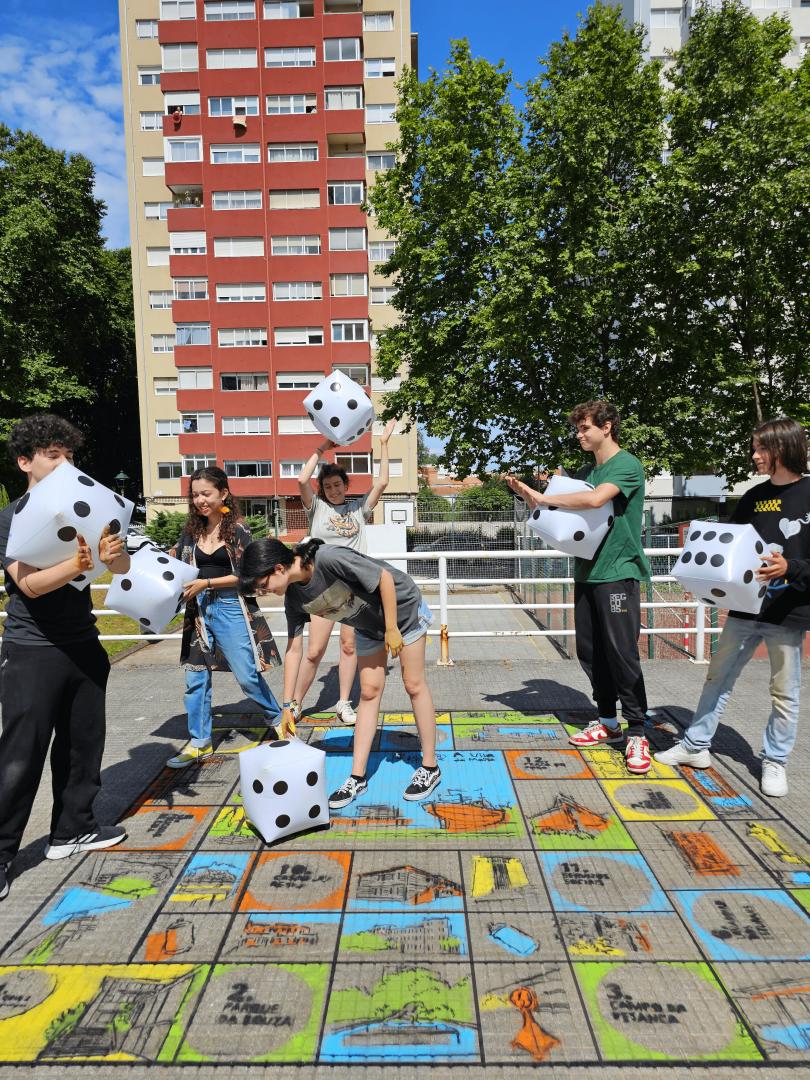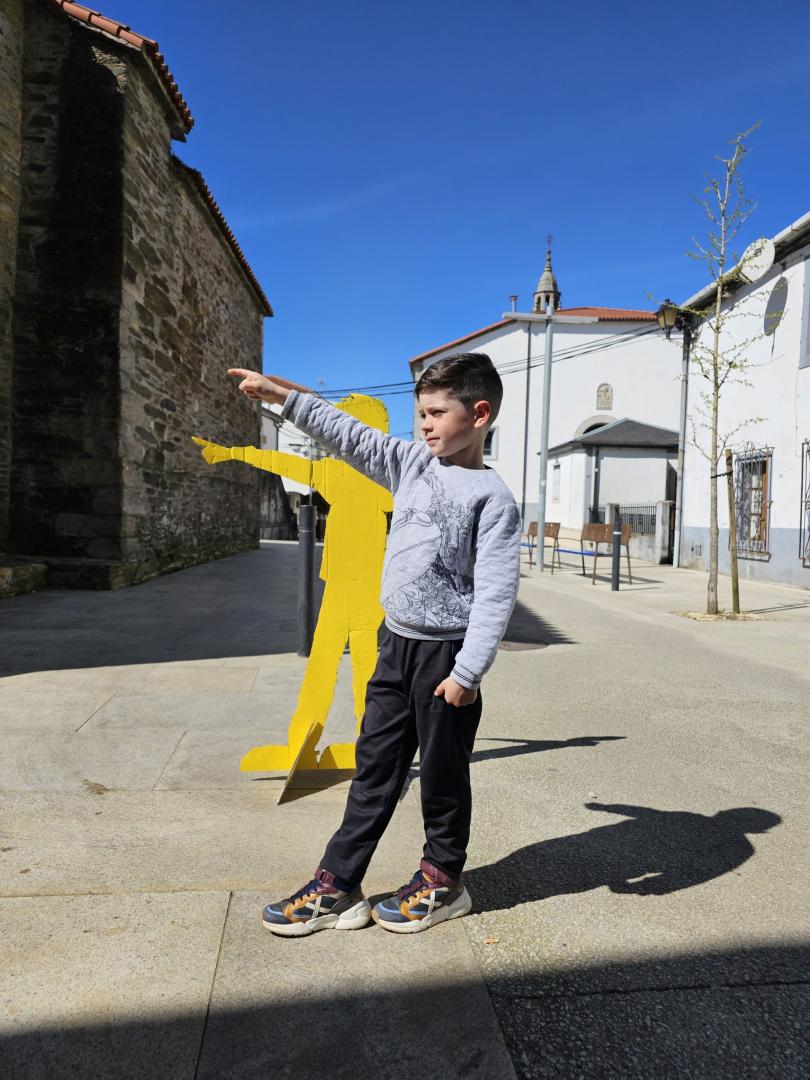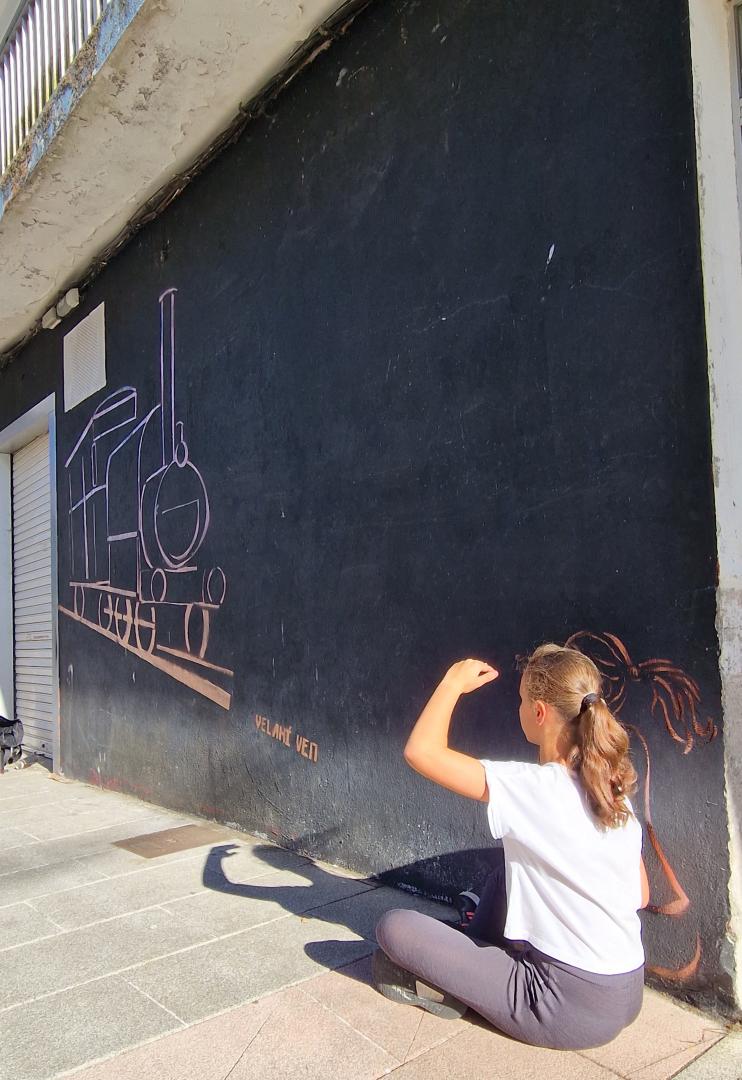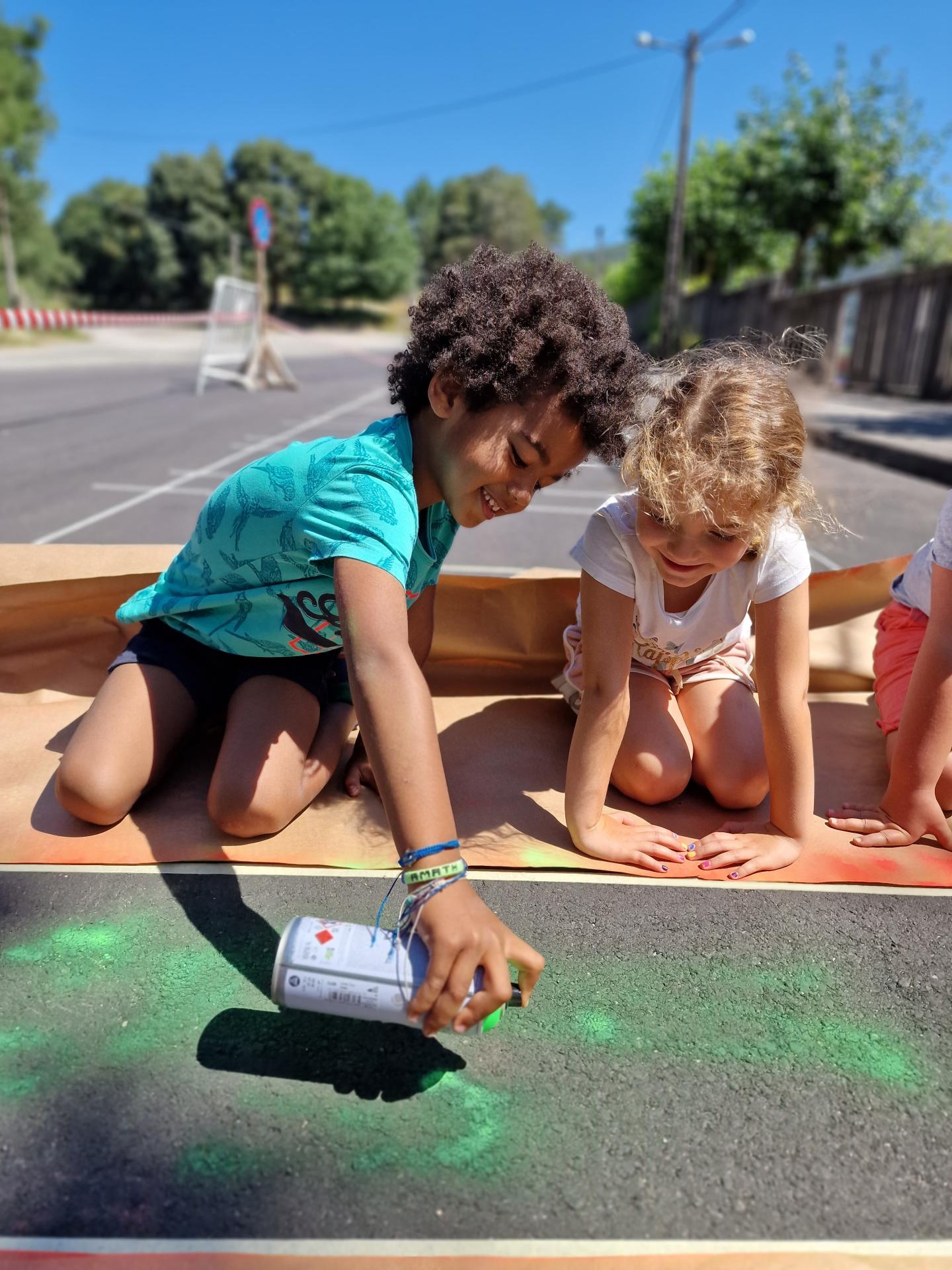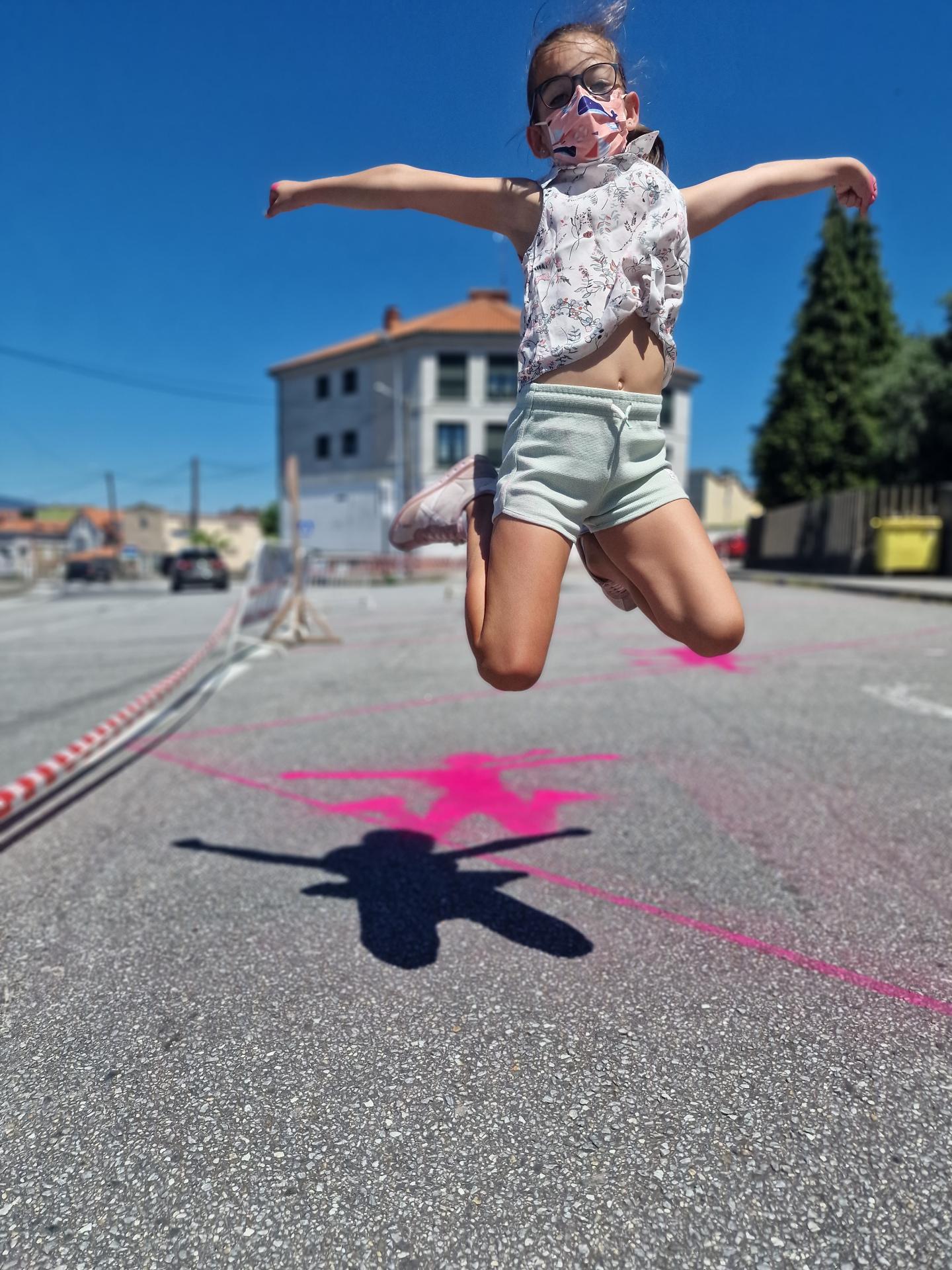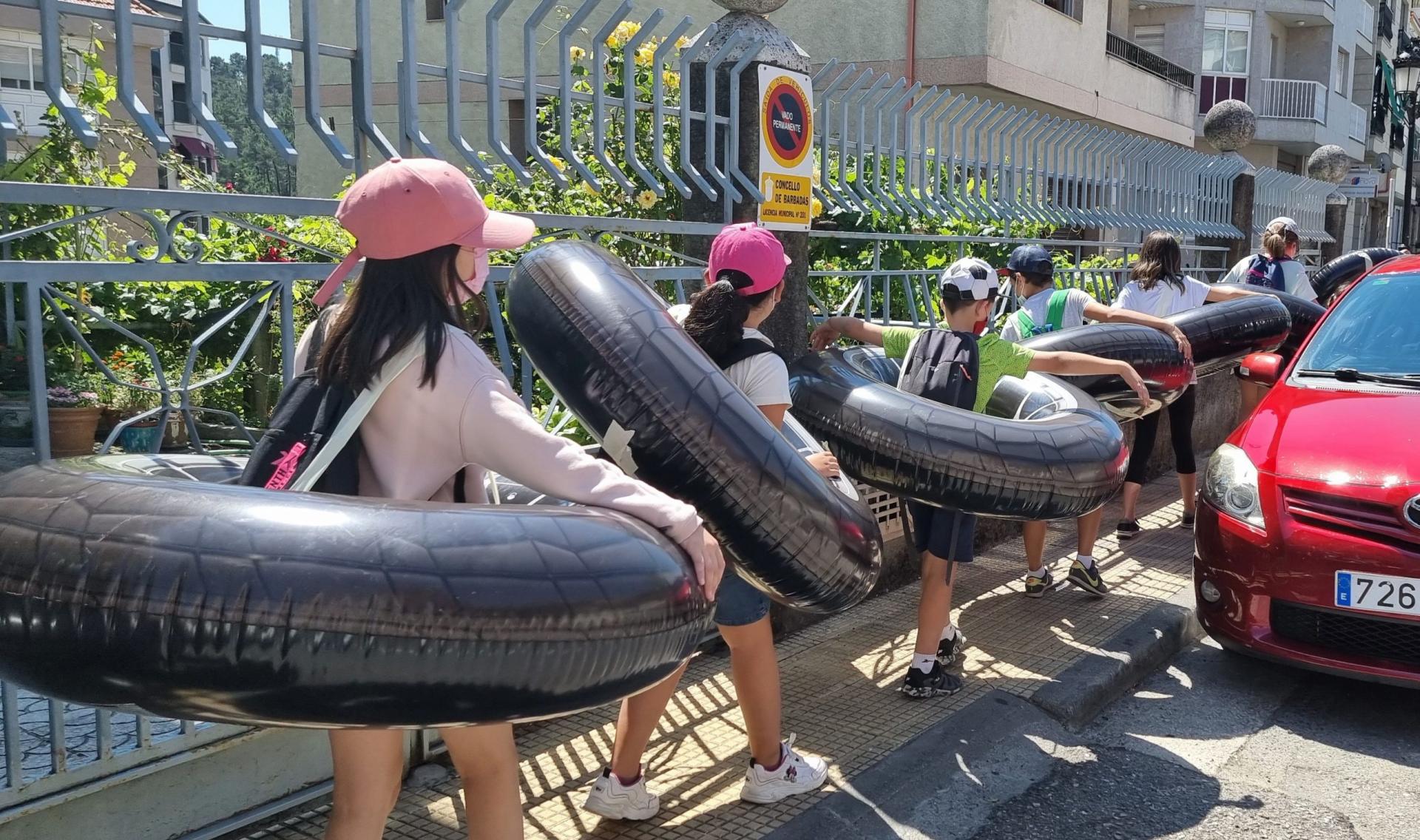"A Vila do Mañá"
Basic information
Project Title
"A Vila do Mañá"
Full project title
"A Vila do Mañá" (The city of tomorrow)
Category
Regaining a sense of belonging
Project Description
“A Vila do Mañá” is an educational and action project, whose main challenge is for children/adolescents to be actively present in the construction processes of the common space. The project arises from the right to the city, whereby the people who live in it have the right to enjoy it, to transform. It gives a voice to those who normally do not have it, promoting their right to be part of an active citizenry, since "protagonist participation" is encouraged with the art and architecture as tools.
Geographical Scope
Regional
Project Region
Galicia (A Coruña, Pontevedra, Ourense and Lugo), Spain
Urban or rural issues
It addresses urban-rural linkages
Physical or other transformations
It refers to other types of transformations (soft investment)
EU Programme or fund
No
Description of the project
Summary
“A Vila do Mañá” is an educational and action project, whose main challenge is for children/adolescents to be actively present in the construction processes of the common space. The project arises from the right to the city, whereby the people who live in it have the right to enjoy it, to transform it and to reflect their way of understanding community life. It gives a voice to those who normally do not have it, children/adolescents, promoting their right to be part of an active citizenry, since they will be the ones who inherit and develop the future city, for which "protagonist participation" is encouraged with the Art/ Architecture as tools to carry it out.
Architecture has an inalienable responsibility in the face of a society that is being redefined. The need to rethink a quality public space that does not prevent socialization and enjoyment of shared spaces is evident. "A Vila do Mañá" takes children out into the street to explore and build these spaces through play, turned into “homo ludens” who, with a limited series of elements, will freely organize their environment, their New Babylon, the Constant Nieuwenhuys' utopia in which the nomadic society constantly adapts its own environment. Their experience does not end in a week of partying in the city, but rather allows them to reconquer the space as their own and generate synergies that spread to the rest of society.
It is necessary to observe the unprejudiced look of those who are used to exploring for the first time and who, faced with the reservations of the adult world, allow themselves to be carried away by curiosity. The project works in search of a new city model where childhood/adolescence are part of active citizenship and have a "protagonist participation" in the creation/transformation of the common space.
To date, the project has been carried out with interesting results in 30 municipalities in Galicia and has worked with 9,800 children and adolescents.
Architecture has an inalienable responsibility in the face of a society that is being redefined. The need to rethink a quality public space that does not prevent socialization and enjoyment of shared spaces is evident. "A Vila do Mañá" takes children out into the street to explore and build these spaces through play, turned into “homo ludens” who, with a limited series of elements, will freely organize their environment, their New Babylon, the Constant Nieuwenhuys' utopia in which the nomadic society constantly adapts its own environment. Their experience does not end in a week of partying in the city, but rather allows them to reconquer the space as their own and generate synergies that spread to the rest of society.
It is necessary to observe the unprejudiced look of those who are used to exploring for the first time and who, faced with the reservations of the adult world, allow themselves to be carried away by curiosity. The project works in search of a new city model where childhood/adolescence are part of active citizenship and have a "protagonist participation" in the creation/transformation of the common space.
To date, the project has been carried out with interesting results in 30 municipalities in Galicia and has worked with 9,800 children and adolescents.
Key objectives for sustainability
_ SOCIAL SUSTAINABILITY: We want to give a voice to those who normally do not have it, girls, boys and adolescents, promoting their right (Article 12 of the Convention on the Rights of the Child. UNICEF. 2006) to form their own judgment of the habitat in which they live and to be able to express it and make it manifest. We seek to stimulate a critical attitude to promote their development as active citizens, because they will be responsible for the city of the future. Conform, therefore, the bases of critical citizenship through “protagonist participation”.
_ ENVIRONMENTAL SUSTAINABILITY: We want to reflect on the way in which we relate to the planet. Make girls, boys and teenagers aware that sustainable consists of a balance between what allows us to develop our lives and what does not compromise the survival of future generations. Thus, we realize that we only have one planet with limited resources, and that it is impossible to maintain our current consumption rate. From "A Vila do Mañá" he worked on a city model, where people are the protagonists, conquering car spaces and trying to promote the idea that more sustainable mobility is possible in our towns.
_ ECONOMIC SUSTAINABILITY: We consider that the Galician towns are the ideal model of what sustainable urbanism can be, they are medium-sized towns, walkable in their entirety in less than fifteen minutes, with a great bond with the natural environment. But today they have a big problem of depopulation, which we believe is due to the loss of identity links with them.
With "A Vila do Maña", the urban space became part of them, they transformed it, made it theirs. They generated bonds with the place. They discovered its transformative capacity. They were the protagonists of the change change that their village is beginning to experience.
We firmly believe that if links are created with the environment I live in, tomorrow will be more complex, that our villages will be depopulated.
_ ENVIRONMENTAL SUSTAINABILITY: We want to reflect on the way in which we relate to the planet. Make girls, boys and teenagers aware that sustainable consists of a balance between what allows us to develop our lives and what does not compromise the survival of future generations. Thus, we realize that we only have one planet with limited resources, and that it is impossible to maintain our current consumption rate. From "A Vila do Mañá" he worked on a city model, where people are the protagonists, conquering car spaces and trying to promote the idea that more sustainable mobility is possible in our towns.
_ ECONOMIC SUSTAINABILITY: We consider that the Galician towns are the ideal model of what sustainable urbanism can be, they are medium-sized towns, walkable in their entirety in less than fifteen minutes, with a great bond with the natural environment. But today they have a big problem of depopulation, which we believe is due to the loss of identity links with them.
With "A Vila do Maña", the urban space became part of them, they transformed it, made it theirs. They generated bonds with the place. They discovered its transformative capacity. They were the protagonists of the change change that their village is beginning to experience.
We firmly believe that if links are created with the environment I live in, tomorrow will be more complex, that our villages will be depopulated.
Key objectives for aesthetics and quality
“A Vila do Mañá” is an educational, dissemination and action project, whose objective is that from childhood and adolescence, through playing and working on protagonist participation, people become aware of all the scales of the common: tangible and intangible heritage, architecture, urban planning and landscape. At the same time, from the architectural discipline, a new vision of the city is obtained, which is the one provided to us by those who will be the inhabitants of tomorrow.
The objective is that from childhood, girls, boys and adolescents are actively present in the construction processes of the common space, providing them with the necessary tools to develop their creativity from art and architecture, in order to provoke. in them the awakening of a new look at the spaces in which they live.
“A Vila do Mañá” works in public spaces to transform them into common spaces. As the geographer and social theorist David Harvey states, the appropriation of urban public spaces by citizens through political action is necessary to convert them into common spaces. The squares and streets, the landscape with its elements..., are common goods that we seek for girls, boys and adolescents to recognize as their own.
Since “A Vila do Mañá” was born in 2016, it has worked with a total of 9,800 participants (from different towns and cities in Galicia, so far it has been carried out in Rianxo, Bertamiráns, Milladoiro, Verín, A Pobra do Caramiñal , Mondoñedo, Ribeira, Carballo, Bueu, Vilagarcía de Arousa, Cambados, Arteixo, Ferrol, A Coruña, Malpica, Arzúa, Silleda, Barbadás, Touro, As Pontes de García Rodríguez, Teixeiro, Curtis, Vimianzo, Vigo and Miño; the project was put to the test , completely changing scale in the city of São Paulo) aged between 3-18 years, who have become the protagonists of change in their cities, sometimes with ephemeral actions and other times permanent. The workshops have produced important urban renovations.
The objective is that from childhood, girls, boys and adolescents are actively present in the construction processes of the common space, providing them with the necessary tools to develop their creativity from art and architecture, in order to provoke. in them the awakening of a new look at the spaces in which they live.
“A Vila do Mañá” works in public spaces to transform them into common spaces. As the geographer and social theorist David Harvey states, the appropriation of urban public spaces by citizens through political action is necessary to convert them into common spaces. The squares and streets, the landscape with its elements..., are common goods that we seek for girls, boys and adolescents to recognize as their own.
Since “A Vila do Mañá” was born in 2016, it has worked with a total of 9,800 participants (from different towns and cities in Galicia, so far it has been carried out in Rianxo, Bertamiráns, Milladoiro, Verín, A Pobra do Caramiñal , Mondoñedo, Ribeira, Carballo, Bueu, Vilagarcía de Arousa, Cambados, Arteixo, Ferrol, A Coruña, Malpica, Arzúa, Silleda, Barbadás, Touro, As Pontes de García Rodríguez, Teixeiro, Curtis, Vimianzo, Vigo and Miño; the project was put to the test , completely changing scale in the city of São Paulo) aged between 3-18 years, who have become the protagonists of change in their cities, sometimes with ephemeral actions and other times permanent. The workshops have produced important urban renovations.
Key objectives for inclusion
Today, and observing the responses of the participants in "A Vila do Maña", we can affirm that the natural connection between girls, boys and adolescents and their habitat, the place where they grow and develop, the village in which they live, is diluted , it barely exists. The village is a hostile environment for them, they have lost their freedom, which is limited to certain areas considered safe and controlled by adults.
Against this image of today's public space, "A Vila do Maña" starts from understanding the neighborhood, the town or the city as an educational tool, not a neutral one, which we approach from the game. Turning their surroundings into a game board and an experimentation laboratory where girls, boys and teenagers are the protagonists of the transformations of their surroundings.
Some of the ideas proposed by the architect Aldo van Eyck are recovered, in which the girl, boy or teenager was given the opportunity to discover the city from their own movement, which has to be developed through their games because it is their way natural to know the world. We are aware that, at present, this generates a conflict in the streets and squares, which we wish to provoke, evidence and make manifest from "A Vila do Mañá". What happens when public spaces are occupied by girls, boys or teenagers?, and what happens when they modify and transform it? From that conflict, we want to transform the image of the town or city that girls, boys and teenagers have and, at the same time, make them visible in those spaces in the eyes of adults.
Learning is sought by acting in reality, locally, by addressing spatial situations that may be known in advance and rediscovered from a new perspective. Action is also sought through the movement of the girl, boy or teenager, to rediscover space from the maximum freedom of play.
Against this image of today's public space, "A Vila do Maña" starts from understanding the neighborhood, the town or the city as an educational tool, not a neutral one, which we approach from the game. Turning their surroundings into a game board and an experimentation laboratory where girls, boys and teenagers are the protagonists of the transformations of their surroundings.
Some of the ideas proposed by the architect Aldo van Eyck are recovered, in which the girl, boy or teenager was given the opportunity to discover the city from their own movement, which has to be developed through their games because it is their way natural to know the world. We are aware that, at present, this generates a conflict in the streets and squares, which we wish to provoke, evidence and make manifest from "A Vila do Mañá". What happens when public spaces are occupied by girls, boys or teenagers?, and what happens when they modify and transform it? From that conflict, we want to transform the image of the town or city that girls, boys and teenagers have and, at the same time, make them visible in those spaces in the eyes of adults.
Learning is sought by acting in reality, locally, by addressing spatial situations that may be known in advance and rediscovered from a new perspective. Action is also sought through the movement of the girl, boy or teenager, to rediscover space from the maximum freedom of play.
Results in relation to category
Indicators of the social impact of "A Vila do Maña" 2023:
We will use 2 quantitative and qualitative indicators of the social impact of the project:
1. "A Vila do Mañá" scientific production
2. Monitoring of the project's media
https://www.dropbox.com/scl/fi/bt2kpfqpk10cc1htuq5l5/Indicators-of-the-social-impact-of-A-Vila-do-Ma.pdf?rlkey=ueprkrydesvdzlttxs71fe85f&dl=0
We will use 2 quantitative and qualitative indicators of the social impact of the project:
1. "A Vila do Mañá" scientific production
2. Monitoring of the project's media
https://www.dropbox.com/scl/fi/bt2kpfqpk10cc1htuq5l5/Indicators-of-the-social-impact-of-A-Vila-do-Ma.pdf?rlkey=ueprkrydesvdzlttxs71fe85f&dl=0
How Citizens benefit
"A Vila do Mañá" is an educational, dissemination and action project, whose aim is that from childhood and adolescence and through play, awareness is gained of all the scales of the common: architecture, tangible and intangible heritage, urban planning and the landscape. We defend the right of girls, boys and teenagers in their villages, as part of active citizenship; which one will inherit and develop the future city; we emphasize the importance of the habitat in which girls, boys and teenagers live, trying to find an identity relationship with it.
"The Village of Tomorrow" starts from understanding the city seen with other eyes, with the eyes of those who will be its heirs. Observing the responses of the participants (9,800) in the different actions (Rianxo, Bertamiráns, Milladoiro, Verín, A Pobra do Caramiñal, Mondoñedo, Ribeira, Carballo, Bueu, Vilagarcía de Arousa, Cambados, Arteixo, Ferrol, Malpica, Buño, Santiago de Compostela , Arzúa, Silleda, Barbadás, Touro, As Pontes de García Rodríguez, Teixeiro, Curtis, Vimianzo and São Paulo), we can say that the natural connection between girls, boys and adolescents and their habitat is barely existent. With "A Vila do Maña", the urban space became part of them, they transformed it, made it theirs. They generated bonds with the place. They discovered its transformative capacity. They were the protagonists of the change that their village is beginning to experience.
With "A Vila do Mañá", the neighborhood, town or city they live in is not an abstract idea, nor is it a series of small partial images; is beginning to be understood as a much more complex and wider environment, which brings us closer to the notion of habitat: the space that transcends its physical location in a territory in which we solve our needs, establishing relationships with other people and with the environment, both natural and built ; involving processes in which it is transformed, but in which we are also transformed.
"The Village of Tomorrow" starts from understanding the city seen with other eyes, with the eyes of those who will be its heirs. Observing the responses of the participants (9,800) in the different actions (Rianxo, Bertamiráns, Milladoiro, Verín, A Pobra do Caramiñal, Mondoñedo, Ribeira, Carballo, Bueu, Vilagarcía de Arousa, Cambados, Arteixo, Ferrol, Malpica, Buño, Santiago de Compostela , Arzúa, Silleda, Barbadás, Touro, As Pontes de García Rodríguez, Teixeiro, Curtis, Vimianzo and São Paulo), we can say that the natural connection between girls, boys and adolescents and their habitat is barely existent. With "A Vila do Maña", the urban space became part of them, they transformed it, made it theirs. They generated bonds with the place. They discovered its transformative capacity. They were the protagonists of the change that their village is beginning to experience.
With "A Vila do Mañá", the neighborhood, town or city they live in is not an abstract idea, nor is it a series of small partial images; is beginning to be understood as a much more complex and wider environment, which brings us closer to the notion of habitat: the space that transcends its physical location in a territory in which we solve our needs, establishing relationships with other people and with the environment, both natural and built ; involving processes in which it is transformed, but in which we are also transformed.
Physical or other transformations
It refers to other types of transformations (soft investment)
Innovative character
It is an innovative project, not only because of the topics it deals with, nor because of who it is aimed at, but because of the way it is carried out.
First of all, it is aimed at children and adolescents, as future citizens of "A Vila do Mañá", generally forgotten in the transformation processes of cities. It is childhood and adolescence that will be responsible for taking care of our material and immaterial heritage and passing it on. If the future inhabitants do not know the environment they live in, tomorrow the mistakes that occurred with previous generations will be repeated, pieces of heritage of incalculable value will be destroyed, or the identity of our towns and cities will be forgotten.
For 5 days the town or city they live in becomes their game board, their laboratory of experimentation. 5 days in which spaces of heritage, architectural or landscape interest are studied, recovered, experienced; the spaces are transformed; the urban landscape is modified and what is more fundamental, they are enjoyed, thus generating a feeling of identity. The town or city in which they live has changed for these girls, boys, girls and young men, it is their town or city, it is their spaces.
The fundamental tool to reach childhood and youth is play, so the activities are based on it. Children and teenagers play, have fun, and discover previously unknown elements of their town or city, learn to see spaces with different eyes, become thinkers of their spaces, and what is most important: they transform their town or city into through leading participation.
In short, the whole town is our laboratory for experimentation, our game board, children and young people rediscover it, enjoy it, take care of it and transform it. Learn by playing.
University students (architecture, landscape, sociology or pedagogy students) participate in "A Vila do Mañá", who are looking for a way to schematize the concepts of heritage, architecture, urban planning, ... Learn by teaching.
First of all, it is aimed at children and adolescents, as future citizens of "A Vila do Mañá", generally forgotten in the transformation processes of cities. It is childhood and adolescence that will be responsible for taking care of our material and immaterial heritage and passing it on. If the future inhabitants do not know the environment they live in, tomorrow the mistakes that occurred with previous generations will be repeated, pieces of heritage of incalculable value will be destroyed, or the identity of our towns and cities will be forgotten.
For 5 days the town or city they live in becomes their game board, their laboratory of experimentation. 5 days in which spaces of heritage, architectural or landscape interest are studied, recovered, experienced; the spaces are transformed; the urban landscape is modified and what is more fundamental, they are enjoyed, thus generating a feeling of identity. The town or city in which they live has changed for these girls, boys, girls and young men, it is their town or city, it is their spaces.
The fundamental tool to reach childhood and youth is play, so the activities are based on it. Children and teenagers play, have fun, and discover previously unknown elements of their town or city, learn to see spaces with different eyes, become thinkers of their spaces, and what is most important: they transform their town or city into through leading participation.
In short, the whole town is our laboratory for experimentation, our game board, children and young people rediscover it, enjoy it, take care of it and transform it. Learn by playing.
University students (architecture, landscape, sociology or pedagogy students) participate in "A Vila do Mañá", who are looking for a way to schematize the concepts of heritage, architecture, urban planning, ... Learn by teaching.
Disciplines/knowledge reflected
One of the starting premises of "A Vila do Maña" is the intergenerational relationship: children and young people learn from future architects, sociologists, pedagogues, artists... while we learn great lessons from childhood and youth, but this relationship does not it remains only here, we try to get the little ones to dialogue with the elders of the place, to transmit knowledge from a previous time "to know the past, to understand the present and be able to look to the future".
For 5 days the town or city they live in becomes their game board, their laboratory of experimentation. 5 days in which spaces of heritage, architectural or landscape interest are studied, recovered, experienced; the spaces are transformed; the urban landscape is modified and what is more fundamental, they are enjoyed, thus generating a feeling of identity. The town or city in which they live has changed for these girls, boys, girls and young men, it is their town or city, it is their spaces.
The fundamental tool to reach childhood and youth is play, so the activities are based on it. Children and teenagers play, have fun, and discover previously unknown elements of their town or city, learn to see spaces with different eyes, become thinkers of their spaces, and what is most important: they transform their town or city into through leading participation.
In short, the whole town is our laboratory for experimentation, our game board, children and young people rediscover it, enjoy it, take care of it and transform it. Learn by playing.
For 5 days the town or city they live in becomes their game board, their laboratory of experimentation. 5 days in which spaces of heritage, architectural or landscape interest are studied, recovered, experienced; the spaces are transformed; the urban landscape is modified and what is more fundamental, they are enjoyed, thus generating a feeling of identity. The town or city in which they live has changed for these girls, boys, girls and young men, it is their town or city, it is their spaces.
The fundamental tool to reach childhood and youth is play, so the activities are based on it. Children and teenagers play, have fun, and discover previously unknown elements of their town or city, learn to see spaces with different eyes, become thinkers of their spaces, and what is most important: they transform their town or city into through leading participation.
In short, the whole town is our laboratory for experimentation, our game board, children and young people rediscover it, enjoy it, take care of it and transform it. Learn by playing.
Methodology used
The actions that are formulated in the workshops are structured through seven fundamental concepts: language, perception, space, landscape, scale, sustainability and the town or city, and four necessary tools: the point, the line, the plane , the three-dimensional element and the natural element. And with the aim that children and adolescents, through the game, become aware of all the scales of the common: architecture, tangible and intangible heritage, urban planning and the landscape, encouraging protagonist participation as part of active citizenship.
Language: Our language as the element that generates identity. With "A Vila do Mañá" Galician is not left alone in its use as a language, if not that it becomes a transforming element of the urban space. It is the words that transform the environment. In recent years, one of the themes of the actions is "working with Galician Literature".
Perception: Apperception of our own body, as well as the perception of the surroundings around us, are fundamental concepts in our workshops.
The space: We look for the work from the space of architecture and the city through the experimentation of light, texture, color, sound, ... The instrument is the body, which travels and plays in space with all senses deployed.
The landscape: Interaction between the built landscape, the more natural landscape and the intermediate territories. Understand how people build the landscape and how the landscape also builds us.
Scale: We introduced the concept of human scale and city scale. Starting from becoming aware of their own body dimensions, the girl, boy, girl or young man can approach other dimensions such as that of the city and that of the territory.
Sustainability: We want to reflect on the way we relate to the planet.
The town or city as our habitat, our game board to discover. Understand its structure, morphological conformation, its voids and its fillings, its history, its traditions and its symbolic and immaterial issues.
Language: Our language as the element that generates identity. With "A Vila do Mañá" Galician is not left alone in its use as a language, if not that it becomes a transforming element of the urban space. It is the words that transform the environment. In recent years, one of the themes of the actions is "working with Galician Literature".
Perception: Apperception of our own body, as well as the perception of the surroundings around us, are fundamental concepts in our workshops.
The space: We look for the work from the space of architecture and the city through the experimentation of light, texture, color, sound, ... The instrument is the body, which travels and plays in space with all senses deployed.
The landscape: Interaction between the built landscape, the more natural landscape and the intermediate territories. Understand how people build the landscape and how the landscape also builds us.
Scale: We introduced the concept of human scale and city scale. Starting from becoming aware of their own body dimensions, the girl, boy, girl or young man can approach other dimensions such as that of the city and that of the territory.
Sustainability: We want to reflect on the way we relate to the planet.
The town or city as our habitat, our game board to discover. Understand its structure, morphological conformation, its voids and its fillings, its history, its traditions and its symbolic and immaterial issues.
How stakeholders are engaged
"A Vila do Mañá" is being developed through different workshops in the Councils of Galicia. It was held in Rianxo, Ames (Bertamiráns and Milladoiro), Verín, A Pobra do Caramiñal, Mondoñedo, Ribeira, Carballo, Bueu, Vilagarcía de Arousa, Cambados, Arteixo, Ferrol, Malpica, Santiago de Compostela, Arzúa, Silleda, Barbadás, Toro, As pontes García Rodríguez, Curtis (Teixeiro and Curtis), Vimianzo, Vigo, Miño and São Paulo (Brazil). It is carried out by the PØSTarquitectos team, it was financed by the different Councils and by the Provincial Council of A Coruña (subsidy program intended for profit-making entities for the production of unique projects of special cultural interest in the province of A Coruña during the year 2019), it receives the support of the Association for the Defense of Galician Cultural Heritage (APATRIGAL), the Research Group on Architectural Composition and Heritage (giCAP) of the University of A Coruña, and the Roberto Rivas Foundation. The project was put to the test, in March 2019, making the leap from the Galician towns to the great metropolis of Paulista with the collaboration of the Gender City and Early Childhood Research Group of the FAU-Mackenzie (Faculty of Architecture and Urbanism of the Mackenzie Presbyterian University) and financed by the Brazilian Institute.
Global challenges
_ SOCIAL SUSTAINABILITY: We want to give a voice to those who normally do not have it, girls, boys and adolescents, promoting their right (Article 12 of the Convention on the Rights of the Child. UNICEF. 2006) to form their own judgment of the habitat in which they live and to be able to express it and make it manifest. We seek to stimulate a critical attitude to promote their development as active citizens, because they will be responsible for the city of the future. Conform, therefore, the bases of critical citizenship through “protagonist participation”.
_ ENVIRONMENTAL SUSTAINABILITY: We want to reflect on the way in which we relate to the planet. Make girls, boys and teenagers aware that sustainable consists of a balance between what allows us to develop our lives and what does not compromise the survival of future generations. Thus, we realize that we only have one planet with limited resources, and that it is impossible to maintain our current consumption rate. From "A Vila do Mañá" he worked on a city model, where people are the protagonists, conquering car spaces and trying to promote the idea that more sustainable mobility is possible in our towns.
_ ECONOMIC SUSTAINABILITY: We consider that the Galician towns are the ideal model of what sustainable urbanism can be, they are medium-sized towns, walkable in their entirety in less than fifteen minutes, with a great bond with the natural environment. But today they have a big problem of depopulation, which we believe is due to the loss of identity links with them.
With "A Vila do Maña", the urban space became part of them, they transformed it, made it theirs. They generated bonds with the place. They discovered its transformative capacity. They were the protagonists of the change change that their village is beginning to experience.
We firmly believe that if links are created with the environment I live in, tomorrow will be more complex, that our villages will be depopulated.
_ ENVIRONMENTAL SUSTAINABILITY: We want to reflect on the way in which we relate to the planet. Make girls, boys and teenagers aware that sustainable consists of a balance between what allows us to develop our lives and what does not compromise the survival of future generations. Thus, we realize that we only have one planet with limited resources, and that it is impossible to maintain our current consumption rate. From "A Vila do Mañá" he worked on a city model, where people are the protagonists, conquering car spaces and trying to promote the idea that more sustainable mobility is possible in our towns.
_ ECONOMIC SUSTAINABILITY: We consider that the Galician towns are the ideal model of what sustainable urbanism can be, they are medium-sized towns, walkable in their entirety in less than fifteen minutes, with a great bond with the natural environment. But today they have a big problem of depopulation, which we believe is due to the loss of identity links with them.
With "A Vila do Maña", the urban space became part of them, they transformed it, made it theirs. They generated bonds with the place. They discovered its transformative capacity. They were the protagonists of the change change that their village is beginning to experience.
We firmly believe that if links are created with the environment I live in, tomorrow will be more complex, that our villages will be depopulated.
Learning transferred to other parties
"A Vila do Mañá" is a methodological project, in fact in 2017 it obtained Honorable Mention in the METHODOLOXIES category in the Ludantia “Educational Projects” contest. I International Biennial of Architecture Education for Children and Youth.
The methodology of "A Vila do Mañá" is easily portable to other regions, in 2019 the project was put to trial working with childhood and adolescence in the occupation in the center of Sao Paulo, where the reality was very different from the Galician vilas, but The problem of the 100 children who lived there was similar to the problem of our neighborhoods and cities, the space that they are allowed to use is a small box, or the rest of the space is prohibited for children and adolescents.
"children and adolescents live in a box, they move in a little box and arrive at a larger box that can be called a school, a shopping center, a sports center or even a playground; their relationship with the city is practically non-existent". Faced with this image of today's public space, “A Vila do Mañá” starts from understanding the neighborhood, the town or the city as an educational, non-neutral tool that we approach from the world. Converting its shape into a game board into an experimentation laboratory. The main objective is to find another model of city, where childhood and adolescence are the protagonists of its surroundings.
The project "A Vila do Maña" is mainly developed in two phases: A first phase of experimentation that is carried out during the development of the actions and a second phase of dissemination in which the results obtained are collected and presented.
The methodology of "A Vila do Mañá" is easily portable to other regions, in 2019 the project was put to trial working with childhood and adolescence in the occupation in the center of Sao Paulo, where the reality was very different from the Galician vilas, but The problem of the 100 children who lived there was similar to the problem of our neighborhoods and cities, the space that they are allowed to use is a small box, or the rest of the space is prohibited for children and adolescents.
"children and adolescents live in a box, they move in a little box and arrive at a larger box that can be called a school, a shopping center, a sports center or even a playground; their relationship with the city is practically non-existent". Faced with this image of today's public space, “A Vila do Mañá” starts from understanding the neighborhood, the town or the city as an educational, non-neutral tool that we approach from the world. Converting its shape into a game board into an experimentation laboratory. The main objective is to find another model of city, where childhood and adolescence are the protagonists of its surroundings.
The project "A Vila do Maña" is mainly developed in two phases: A first phase of experimentation that is carried out during the development of the actions and a second phase of dissemination in which the results obtained are collected and presented.
Keywords
protagonist-participation
right to the city
identity ties
childhood
game

